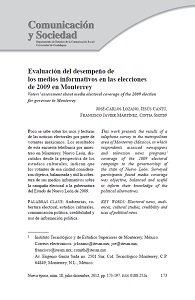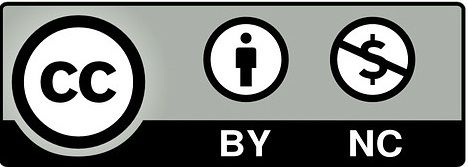Evaluación del desempeño de los medios informativos en las elecciones de 2009 en Monterrey
DOI:
https://doi.org/10.32870/cys.v0i18.195Palabras clave:
Audiencias, cobertura electoral, estudios culturales, comunicación política, credibilidad y uso de información políticaResumen
Poco se sabe sobre los usos y lecturas de las noticias electorales por parte de votantes mexicanos. Los resultados de esta encuesta telefónica por muestreo en Monterrey, Nuevo León, discutidos desde la perspectiva de los estudios culturales, indican que los votantes de esa ciudad consideraron objetiva, balanceada y útil la cobertura de sus medios informativos sobre la campaña electoral a la gubernatura del Estado de Nuevo León de 2009.Descargas
Citas
Abbe, O. G., Goodliffe, J., Herrnson, P. S. & Patterson, K. D. (2003). Agenda setting in congressional elections: The impact of issues and campaigns on voting behavior. Political Research Quarterly, 56 (4), 419-430.
Abundis, F. (2006). Los medios de comunicación en México. Revista AMAI. Recuperado el 23 de enero de 2011 de http://www.amai.org/pdfs/revista-amai/AMAI-13_art8.pdf
Bennett, S. E., Rhine, S. L., & Flicksinger, R. S. (2004). The things they cared about: Change and continuity in American attention to different news stories 1989-2002. The International Journal of Press/ Politics, 9 (1), 75-99.
Bregman, D. (1998). La función de agenda: una problemática en transformación. En J. Ferry, D. Wolton y et al. (Comps.), El nuevo espacio público. Madrid, España: Gedisa.
Brunner, J. J. (1997, 22 de julio). Ciudadanía y participación: notas para la discusión. Recuperado el 17 de septiembre de 2011 de http://mt.educarchile.cl/mt/jjbrunner/archives/Ciud+Part.pdf
Buckingham, D. (1999). Young people, politics and news media: Beyond political socialisation. Oxford Review of Education, 25 (1-2), 171-184.
Cantú, J., Lozano, J. C., Martínez, F. J. & Smith, C. (2011). Elecciones y medios de comunicación locales: el caso de la prensa y la televisión en las elecciones a la gubernatura de Nuevo León en 2009. Manuscrito.
Colwell, R. (1979). Mass media use and voting behavior: The accuracy of political perception among first-time and experienced voters. Communication Research, 6 (4), 407-436.
Comisión Estatal de Nuevo León (2009). Lista nominal por municipios. Recuperado el 28 de noviembre de 2009 de http://www.cee-nl.org.mx/listanominal.asp#.
Dahlgren, P. (2006). Doing citizenship: The cultural origins of civic agency in the public sphere. European Journal of Cultural Studies, 9 (3), 267-286.
Dahlgren, P. & Gurevitch, M. (2005). Political communication in a changing world. En J. Curran & M. Gurevitch (Eds.), Mass media and society (pp. 375-393). Londres, Ingalterra: Hodder Arnold.
David, C. C. (2009). Learning political information from the news: A closer look at the role of motivation. Journal of Communication, 59 (2), 243-261. doi: 10.1111/j.1460-2466.2009.01414.x
De las Heras, M. (2006). Por quién vamos a votar y por qué. México: Nuevo Siglo Aguilar.
De Vreese, C. H. (2004). The effects of frames in political television news on issue interpretation and frame salience. Journalism & Mass Communication Quarterly, 81 (1), 36-52.
Domínguez, J. I. & Lawson, C. H. (2004). Mexico’s pivotal democratic election: Candidates, voters, and the presidential campaign of 2000. Stanford, ca, EE.UU.: Stanford University Press.
Domínguez, J. I., Lawson, C. H. & Moreno, A. (2009). Consolidating Mexico’s democracy: The 2006 presidential campaign in comparative perspective. Baltimore, Md, EE.UU.: Johns Hopkins University Press.
Esteinou, J. (2007). La videocracia mexicana y las elecciones presidenciales de 2006. En L. Escudero (Ed.), Democracias de opinión: medios y comunicación política en las elecciones mexicanas 2006 (pp. 49-70). Buenos Aires, Argentina: La Crujía.
Eveland, W. P., Shah, D. V., & Kwak, N. (2003). Assessing causality in the cognitive mediation model: A panel study of motivations, information processing, and learning during campaign 2000. Communication Research, 30 (4), 359-386. doi: 10.1177/0093650203253369
Farnsworth, S. J., & Lichter, S. R. (2007). The nightly news nightmare: Television’s coverage of u.s. presidential elections, 1988-2004 (2ª ed.). Lanham, MD, EE.UU.: Rowman & Littlefield Publishers.
Flores, J. & Meyenberg, Y. (2000). Ciudadanos y cultura de la democracia: reglas, instituciones y valores. Encuesta nacional. México: UNAM/IFE.
Gauntlett, D. & Hill, A. (1999). tv living: Television, culture, and everyday life. Londres, Inglaterra: Routledge.
Gobierno del Estado de Nuevo León (2010). Estadísticas. Recuperado el 5 de mayo de 2010 de http://www.nl.gob.mx/?P=nl_poblacion
Graber, D. A. (1993). Processing the news: How people tame the information tide. Lanham, MD, EE.UU.: University Press of America.
Hacker, K., Coste, T. G., Kamm, D. & Bybee, C. (1991). Opositional readings of network tv news. Discourse and Society, 2 (2), 183-202.
Hall, S. (1980). Encoding/Decoding. En D. H. Stuart Hall, Andrew Lowe & Paul Willis (Ed.), Culture, Media, Language. Londres, Inglaterra: Hutchinson.
Hermes, J. (2005). Re-reading popular culture. Malden; Oxford: Blackwell Pub.
Hernández, M. A. (2008). La democracia mexicana, presa de una cultura política con rasgos autoritarios. Revista Mexicana de Sociología, 70 (2), 261-303.
Hollander, B. A. (2007). Media use and political involvement. En R. W. Preiss, B. M. Gayle, N. Burrell, M. Allen & J. Bryant (Eds.), Mass media effects research: Advances through meta-analysis (pp. 377-390). Nueva York, ee.uu.: Lawrence Erlbaum Associates, Publishers.
Hughes, S. & Lawson, C. (2004). Propaganda and crony capitalism: Partisan bias in Mexican television news. Latin American Research Review, 39 (3), 81-105.
Jensen, K. B. (1988). News as social resource: A qualitative empirical study of the reception of Danish television news. European Journal of Communication, 3, 275-301.
Jensen, K. B. (1998). News of the world: World cultures look at television news. Londres; Nueva York: Routledge.
Lawson, C. (2008). Election coverage in Mexico: Regulation meets crony capitalism. En J. Strömbäck & L. L. Kaid (Eds.), The handbook of election news coverage around the world. Nueva York, EE.uu.: Routledge.
Lewis, J. (1997). What counts in cultural studies. Media Culture & Society, 19 (1), 83-97.
Liebes, T. (2005). Viewing and reviewing the audience: Fashions in communication research. En J. Curran & M. Gurevitch (Eds.), Mass media and society (pp. 356-374). Londres, Inglaterra: Hodder Arnold.
Livingstone, S. M. (Ed.). (2005). Audience and publics: When cultural engagement matters for the public sphere. Portland, or, EE.UU.: Intellect Books.
Lozano, J. C. (2006). Political advertising in Mexico. En L. L. Kaid & C. Holtz-Bacha (Eds.), The Sage handbook of political advertising (pp. 259-268). Thousand Oaks, CA, EE.UU.: Sage.
Madianou, M. (2005). The elusive public of television news. En S. Livingstone (Ed.), Audiences and publics: When cultural engagement matters for the publich sphere (pp. 99-114). Bristol, Inglaterra: Intellect.
Moores, S. (2005). Media/theory: thinking about media and communications. Londres Nueva York: Routledge.
Morley, D. (1980). The “Nationwide” audience: Structure and decoding. Londres, Inglaterra: British Film Institute.
Morley, D. (1985). Cultural transformations: The politics of resistance. En M. Gurevitch & M. R. Levy (Eds.), Mass Communication Review Yearbook (pp. 237-250). Newbury Park, CA, EE.UU.: Sage.
Nadeau, R., Nevitte, N., Gidengil, E., & Blais, A. (2008). Election campaigns as information campaigns: Who learns what and does it matter? Political Communication, 25 (3), 229-248. doi: 10.1080/10584600802197269
Orozco, G. (1997). La televidencia de lo político: un complejo proceso de mediaciones. Oficios Terrestres (4), 18-21.
Orozco, G. & Medina Jackson, D. (2000). Supertemas noticiosos en la televisión mexicana. Análisis de la información en los noticiarios 24 Horas y Hechos. Comunicación y Sociedad (37), 53-86.
Pew Research Center (2009). Public evaluations of the news media: 1985-2009. Recuperado el 15 de marzo de 2010 de http://www.people-press.org
Putnam, R. D. (2000). Bowling alone: The collapse and revival of American community. Nueva York, EE.UU.: Simon & Schuster.
Rhee, J. W., & Cappella, J. N. (1997). The role of political sophistication in learning from news: Measuring schema development. Communication Research, 24 (3), 197-233.
Sartori, G. (1998). Homo videns: la sociedad teledirigida. Madrid, España: Taurus Ediciones.
Scammell, M. & Semetko, H. A. (2008). Election news coverage in the U.K. En J. Strömbäck & L. L. Kaid (Eds.), The handbook of election news coverage around the world. Nueva York, ee.uu.: Routledge.
Secretaría de Gobernación (2008). Encuesta Nacional sobre Cultura Política y Prácticas Ciudadanas. Recuperado el 28 de noviembre de 2009 de: http://www.encup.gob.mx/en/Encup/Cuarta_ENCUP_2008
Sigman, S. J. & Fry, D. L. (1985). Differential ideology and language use: Readers’ reconstructions and descriptions of news events. Critical Studies in Media Communication, 2 (4), 307-322.
Strömbäck, J. & Kaid, L. L. (2008). A framework for comparing election news coverage around the world. En J. Strömbäck & L. L. Kaid (Eds.), The handbook of election news coverage around the world. Nueva York, EE.UU.: Routledge.
Tenenboim-Weinblatt, K. (2009). “Where is Jack Bauer when you need him?”. The uses of television drama in mediated political discourse. Political Communication, 26 (4), 367-387. doi: 10.1080/10584600903296960
Van Zoonen, L. (2007). Audience reactions to Hollywood politics. Media, Culture & Society, 29 (4), 531-547.
Van Zoonen, L. (2005). Entertaining the citizen: When politics and popular culture converge. Lanham, MD, EE.UU.: Rowman & Littlefield.
Van Zoonen, L. (2004). Imagining the fan democracy. European Journal of Communication, 19 (1), 39-52.
Weaver, D. & Drew, D. (2001). Voter learning and interest in the 2000 presidential election did the media matter? Journalism & Mass Communication Quarterly, 78 (4), 787-798.

Descargas
Publicado
Cómo citar
Número
Sección
Licencia
Los autores/as que publiquen en esta revista aceptan las siguientes condiciones:
De acuerdo con la legislación de derechos de autor, los autores conservan los derechos de autoría y otorgan a Comunicación y Sociedad el derecho de primera comunicación pública de la obra. Comunicación y Sociedad no realiza cargos a los autores por enviar y procesar artículos para su publicación.
Los autores/as pueden realizar otros acuerdos contractuales independientes y adicionales para la distribución no exclusiva de la versión del artículo publicado en Comunicación y Sociedad (por ejemplo incluirlo en un repositorio institucional o publicarlo en un libro) siempre que indiquen claramente que el trabajo se publicó por primera vez en Comunicación y Sociedad.
























